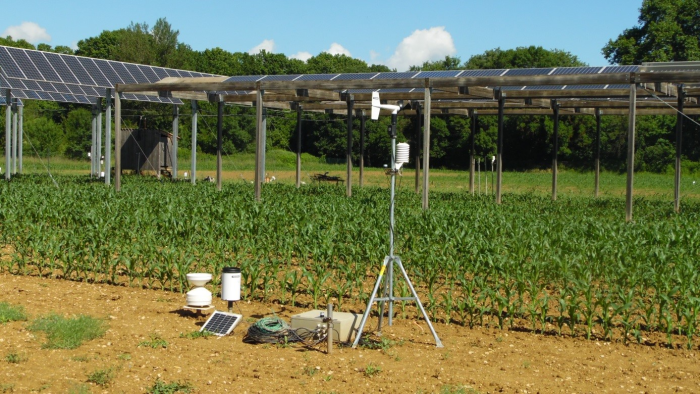




Agrivoltaics or dual-use solar is a system combining an agricultural crop (viticulture, arboriculture, field crops, or market gardening) and photovoltaic panels on the same surface area, positioned high up and controlled as per the plant's physiological needs. This innovative technology aims to improve the agricultural production by modifying the climate above plants, then producing clean, renewable, and low-cost electricity. As part of the Sun'Agri program run by Sun'R company, the IRSTEA (UMR G-eau, Montpellier) is studying the importance of the shade created by variable slope photovoltaic panels on crops with the goal of reducing water consumption and thus increasing the efficiency of water use in agriculture. Ultimately, this work will help adapt and feed crop development and water balance models to optimize shade management via the incline of the photovoltaic panels. This optimization should then improve the agricultural yield (quantity and/or quality) to promote the development of renewable energies and maximize the efficiency of land use while saving water resources.
To reach this goal, four agrivoltaic devices have been or will be built in the south of France on field crops, vines, vegetable crops, and apple trees as part of the Sun'Agri 3 Investment Program funded by ADEME. These devices are equipped with Campbell Scientific equipment to enable the following:
- Evaluation of the effect of shading on microclimate and evapotranspiration using SP1110 radiation sensors, CS215 thermo-hygrometers, ARG100 rain gauges, and wind monitors (05103-5)
- Monitoring of crop water consumption using CS650 soil water content reflectometers
Case Study Summary
Application
Measurement of water balance variables with agrivoltaic devicesLocation
France (Montpellier – Tresserre – Mallemort – Piolenc)Products Used
CR1000 AM16/32B CS650 CS215-L 05103-LContributors
Dr. Yassin Elamri, Irstea Research EngineerParticipating Organizations
Sun’R, Sun’R Smart Energy, IRSTEA, INRA, PhotowattMeasured Parameters
Solar radiation, air temperature and relative humidity, wind speed and direction, precipitation, water content, and soil temperatureRelated Website
Sun'Agri IRSTEA UMR G-EAU ADEMEView the PDF